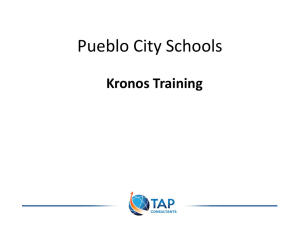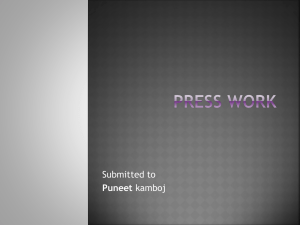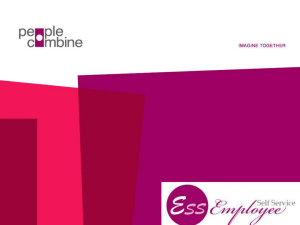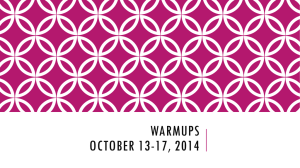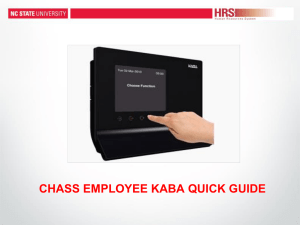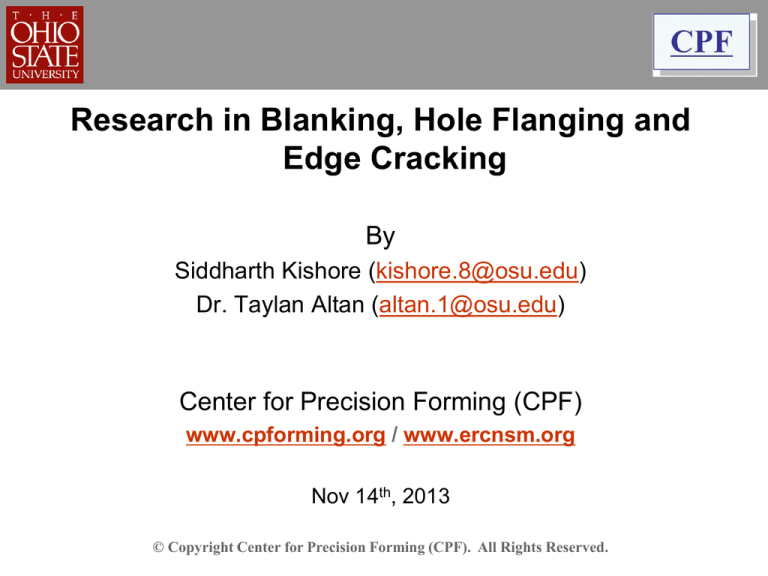
Research in Blanking, Hole Flanging and
Edge Cracking
By
Siddharth Kishore (kishore.8@osu.edu)
Dr. Taylan Altan (altan.1@osu.edu)
Center for Precision Forming (CPF)
www.cpforming.org / www.ercnsm.org
Nov 14th, 2013
© Copyright Center for Precision Forming (CPF). All Rights Reserved.
Introduction
• Blanking is an integral part of sheet forming operations.
• Important issues that require attention in blanking are
1. Achieving ‘good’ part edge quality
2. Reverse loading during blanking of high strength materials
3. Tool failure
4. Blanking using servo-presses
2
Introduction
vp
Punch
rp
Roll over zone (Zr)
fb
dp
Shear zone (Zr)
Blank Holder
rd
DIE
db
dd
h
t
Fracture zone (Zf)
vp=punch velocity
fb=blankholder force (bhf)
dp=punch diameter
dd=die diameter
t =sheet thickness
rd=die radius
rp=punch radius
db=diameter of blankholder
h=distance between sheet and blankholder
Burr zone (Zb)
Blanked edge (obtained from
simulations)
Schematic of the blanking process
3
1. Edge quality
• Hole flanging / edge cracking of advanced high strength steels (AHSS) is
challenging because of the low formability of the material.
• Edge formability / hole flangeability can be improved by improving the
blanked / pierced edge quality.
• Higher flangeability requires lower hardness (lower strain) on the blanked
/ pierced edge.
• The optimum blanking parameters to obtain lowest hardness (and strain)
on the blanked edge have to be determined for AHSS.
Factors influencing edge quality:
(i) punch-die clearance and concentricity (ii) blank holder pressure
(iii) punch tip geometry (iv) punch velocity (v) tool wear/radius
(vi) sheet material/thickness
4
1. Edge quality
• Several researchers have noted that the quality of the sheared
edge zone affects the flangeability and HER of the sheet.
• The quality of the sheared edge can be quantitatively expressed
in terms of hardness at the sheared edge.
• A better edge has lower hardness at the sheared edge.
• Many applications demand a certain shear zone and fracture
zone limit in the hole/blank for good fitment/alignment.
5
1. Edge quality
Factors influencing the Hole Expansion
Ratio (HER):
• Edge quality of the hole
• The method used to finish the hole (e.g.
blanking, reaming etc.)
• Punch/die clearance used in blanking
• Positioning of burr with respect to punch
• Sheet material / thickness
dd
DIE
rd
dh
θ
dp
Blank Holder
fb
Punch
db
vp
vp=punch velocity
fb=blankholder force
θ=punch angle (conical)
dd=diameter of the die
db=diameter of blankholder rd=die radius
dh=diameter of pierced hole in the blank
dp=punch diameter (hemispherical)
Schematic of hole expansion test
Formed specimen - hole expansion test with
conical punch [Sadagopan et al., 2003]
6
1. Edge quality
FE Simulation of Blanking
Influence of temperature on FE simulation of blanking
(a)
(b)
(a) Experimental sheared edge geometry
from blanking DP 590, using 13.5%
punch/die clearance [Konieczny, 2007], and
(b) sheared edge from the
FE simulation, with temperature distribution
Load vs. stroke curve from FE
simulations of blanking of 1 mm thick
DP 590 with 1.1% punch/die
clearance, considering isothermal
7
and non-isothermal conditions.
1. Edge quality
FE Simulation of Hole Expansion
Effect of punch geometry on hole expansion test
Conical Punch
P1, Outer edge
Spherical Punch
P1, Outer edge
Distributions of damage values (DV) at the sheared edge explain the effect of punch
geometry. Spherical punch yields more uniform distribution of DVs along the sheared
edges and thus the influence of burr orientation on expansion ratio is less significant
for this punch geometry.
8
1. Edge quality
Different ways to improve edge quality: Punch geometry
Gradually contacting punch for improving
stretch flangability [Mori et. al., 2013]
Humped bottom punch to improve
HER [Takahashi et. al., 2013]
9
Simulation study - Objectives
Overall Objectives
The overall objectives of the study are to:
a) Understand the factors that affect the quality of pierced/blanked edge
as well as Hole Expansion Ratio (HER) and edge cracking.
b) Develop guidelines for optimum blanking conditions for given sheet
material, thickness and hole diameter (or curvature).
The important parameters that can affect the blanked edge quality and the hole
expansion ratio, flangeability are
(i) punch-die clearance
(ii) blank holder pressure
(iii) punch tip geometry
(iv) punch velocity
(v) hardness of blanked/pierced edge
(vi) surface quality of the blanked/pierced edge.
10
Simulation study – Punch shapes
used
Punch Shapes Used in Simulations
Note: Simulations were conducted with true stress-true strain data independent of
temperature and strain rate. However, temperature due to deformation were estimated.
20 mm
20 mm
0.7 mm
20 mm
45
0.7 mm
8.26
mm
Flat Bottom Punch
Dimensions from
[Takahashi et al., 2013]
(Geometry-1)
Humped Bottom Punch
Dimensions from
[Takahashi et al., 2013]
(Geometry-2)
20 mm
0.7 mm
8.26
mm
Conical punch-flat (For
comparison)
(Geometry-3)
Conical punch pointed(For
comparison)
(Geometry-4)
A corner radius of 0.1 mm was used at all sharp edges.
11
Simulation study - Results
3
Effect of punch tip geometry on strain
along the blanked edge
2.5
Effective Strain
humped
flat
2
1.5
1
0.5
0
0
1
2
3
4
Distance from the top surface of the sheet
(mm)
Simulations – Conducted by CPF
Experiments – Conducted by
[Takahashi et al., 2013]
Note: Type 1 denotes flat punch and
type 2 denotes humped bottom punch
12
Simulation study - Results
Effect of punch tip geometry on strain along the
blanked edge - finer mesh
4
Punch
geometry
Average
effective
strain
Avg
maximum
strain
Flat (1.2)
1.23
1.99
2.5
Humped
(2.2)
1.06
1.57
2
Conical
punch –
Flat (3.3)
0.85
1.1
Conical
punch –
Pointed
(4.1)
1.08
2
3.5
humped
flat
conical - flat
conical - pointed
Effective Strain
3
1.5
1
0.5
0
0
1
2
3
4
Distance from the top surface of the sheet (mm)
5
Conical-flat punch gives the least average strain at the edge as
well as the least maximum strain at the edge.
13
2. Reverse load in blanking
• Reverse tonnage occurs
when the material “snaps
through” during a
blanking operation.
• If this unchecked reverse
tonnage exceeds the
press capacity, it leads
to excessive tool wear,
unscheduled
maintenances and
catastrophic failure.
14
2. Reverse load in blanking
The reverse loads depends on:
• Total tonnage
• A very small tool in the center of a very large bed will actually
produce more reverse tonnage than if the same tool is run on a
press bed that closely matches the tool’s size.
Avoiding it:
• Tonnage should be monitored using a tonnage monitor.
• Tool size and press bed size should be matched.
• Staggering tools
• Shock dampers and other components to absorb reverse
tonnage.
• Servo press
15
3. Tool life in blanking
• Common issue in blanking of advanced / ultra high strength
steel (AHSS / UHSS) or high volume blanking of thin sheets
(~ 0.2mm).
• Various parameters like sheet material and thickness, punch
material and coating, punch-die clearance and punch velocity,
punch/die corner corner radii influence punch life.
• Newer and better punch materials and coatings may help in
extending punch life.
• Punch/die geometry can also be modified to improve punch
life without much sacrifice in blanked edge quality.
16
3. Tool life in blanking
Experiments by [Högman 2004]
•
•
•
(a) Uniform clearance
(10%)
Chipped after 40,000 strokes
(b) Larger clearance
(27%)
No chipping after 200,000 strokes
Maximum Punch Stress (Simulations at ERC/NSM)
2010 MPa
Sheet material - Docol800 DP,
1mm thick.
Punch material – Vanadis 4, 60
HRC
Punch wear from experiments
correlate with punch stress from
FEA.
2270 MPa
Reference: [Högman, 2004] Punching tests of ehs- and
uhs- steel sheet. Recent Advances in Manufacture & Use
of Tools & Dies. October 5-6, 2004, Olofström, Sweden
17
3. Tool life in blanking
Conclusions
• Optimize the punch-die clearance for the blanking operation.
• A punch-die clearance that is variable at the contour of a part
gives a more uniform punch stress This results in more uniform
punch wear, thereby improving punch life considerably.
• FEM simulations conducted at CPF matched experimental results
from [Högman 2004]
18
4. Blanking using servo press
The flexibility of slide motion in servo drive (or free motion) presses.
[Miyoshi, 2004]
19
4. Blanking using servo press
Slide motion used for partial and
finish blanking [Miyoshi, 2004 /
Komatsu]
Precision Formed Part a) partially
blanked, b) finished blanked
[Miyoshi, 2004 / Komatsu]
20
Questions/Comments
Taylan Altan
(altan.1@osu.edu)
Ph +1-614-292-5063
Please visit
www.ercnsm.org
and www.cpforming.org
for detailed information
21

